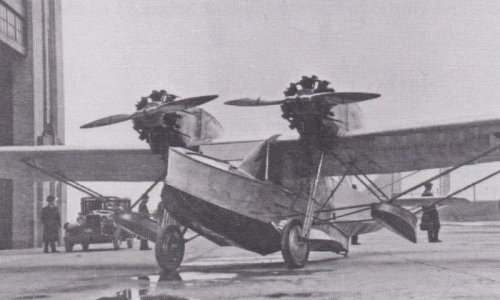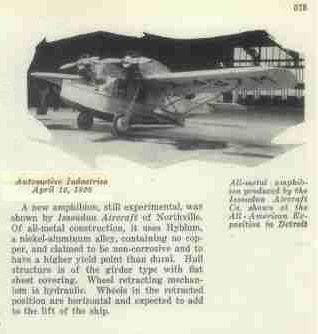Dynoman said:
According to the Ludington Daily News on March 30, 1930, A. C. Hamilton was identified as the designer of a new amphibian, stating that "Announcement was made here last night of a $500,000 concern, the Issoudun Aircraft Co., to manufacture a new type of amphibian plane designed by A. C. Hamilton, Maj. S. G. M. Lanphier, former commandant of Selfridge Field, will be president of the company, and Mr. Hamilton will be vice president."
Detroit Free Press March 29, 1930 also relates A.C. Hamilton as the designer of the Lanphier aircraft and that Hamilton is said to be "one of the oldest designers and fliers in the country" and that Hamilton competed in air races against Graham White, Farman, and Bleriot.
For immediate relatives, Thomas F. Hamilton had one younger brother named Edgar Charles Hamilton, listed from a biography found in Wikipedia (for what its worth). I did not find any other designs for A.C. Hamilton and did not find a relation to the engineer Alexander Hamilton. I'll keep an eye out for any connections.
Thanks a lot
Dynoman, for your extensive search. I did indeed find out about Edgar Charles, and since he was also busy in aviation (though moderately compared to his elder brother) I was wondering if the "A. C." might have been a typo for E. C. Hamilton...
However, since you've now clearly found two separate period references to A. C. Hamilton, and a most crucial reference to him being "one of the oldest designers and fliers in the country", I think we can now clearly establish that "A. C." was my second option, the Alexander Hamilton who had worked as a constructing engineer circa 1910 for the Brooks Aeroplane Co. in Saginaw, Michigan, for which he had designed a "Biplane", a "Tractor-Biplane", a "Hydroaeroplane" and a "Monoplane", all supposedly test-flown by legendary aviator Hillery Beachey. The Michigan area location is of course an additional element to back up that conclusion.
My research into the Issoudun H-23 has been tedious and produced little fruit, but I did gather up some interesting facts:
[list type=decimal]
[*]Thomas G. Lanphier, Sr. was a retired U.S. Army Air Corps Colonel and an American aviation pioneer. He received pilot training at Issoudun Aerodrome, France, where he was in command of the American base (which explains the name he later gave to his company). He was a friend and business partner of Colonel Charles Lindbergh, and one of his flying instructors. Before founding the short-lived Issoudun company, he had taken the helm of the Transcontinental Air Transport Co. in 1928 and also created a U. S. airfield that was a copy of the French Issoudun aerodrome, which he considered a model of its kind. He became the president of the Bird Aircraft Corp. in 1931 (interestingly, it seems a Bird aircraft was already displayed by Issoudun at the 1930 Detroit show even before he had formally joined the company).
[*]The H-23 was registered in Detroit but was built in Northville, Mich., in the Cadillac Aircraft Corporation's factory (which was the ex-Stinson factory). Although it would appear that the company's headquarters were officially in Detroit, most publications of the time placed it in Northville because that's where the aircraft was built.
[*]Identifying the exact company name from period articles is a hopeless quest... The firm is called Issoudun Aircraft Corp. by Aero Design (April 1930 issue) and Aeronautics (May 1930), but Automotive Industries and Aviation Week both refered to it in April 1930 as the Issoudun Aircraft Co. (not to mention the fact that Robert F. Pauley calls it the Issoudun Aircraft Manufacturing Corporation in his book Michigan Aircraft Manufacturers, as has already been said)
[*]According to Aero Digest (May 1930), which was covering the 1930 Detroit show (where the Issoudun was exhibited next to the large Fokker transports) the H-23 was powered neither by 90hp nor 125hp engines, but "by two Warner 110-horsepower engines." The item's conclusion gave an interesting clue as to the probable reason for the H-23's vanishing into oblivion: "It is highly experimental and appears to need a reworking." The post-crash market was such that a "reworking" of the type was likely not deemed viable, and Lanphier was already busy with Bird Aircraft by then.
[/list]




